First, you will define a punch in Part Design, in the absolute axis
system.
Then, in a Sheet Metal part, you will bring the punch feature (and its axis
system) to a point you have selected. If necessary, you will define a
rotation of the axis system from a reference line.
This user-defined stamping cannot be combined with the Punch and Die approach.
![]()
-
Start the Part Design application.
-
Insert a PartBody (menu Insert -> Body) to define the punch.
-
Enter the sketcher
 select the yz plane, and draw the profile of the punch.
select the yz plane, and draw the profile of the punch. -
Return to the 3D space and create the punch using the pad icon
 and the fillet icon
and the fillet icon
 .
.
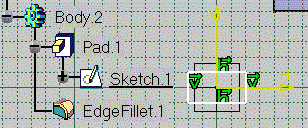
- The punch can be defined in the Sheet Metal part where the stamping is
to be created or in another part.
In this case, when selecting the punch feature, the system automatically copies it into the .CATPart document into which the wall to be stamped is located.
A link is retained between the initial punch feature and its copy. - If you define a punch with cutting faces, they should come below the sheet.

-
Return to the Sheet Metal application, and if needed, use the Define In Work Object on the PartBody containing the wall to be stamped.
-
Click the User Stamping icon
 from the
Stamping tool bar and select a wall or a face where the stamping is to be
created.
from the
Stamping tool bar and select a wall or a face where the stamping is to be
created.
This wall or face is used to define the stamping location and direction, by matching the punch's origin to the selected point on the wall.
The User Defined Stamp Definition dialog box is displayed, along with a grid that will help you position the punch.
-
Click the With cut-out and opening
 icon.
icon.
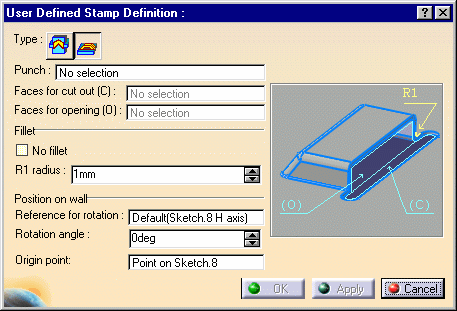
-
Select the punch (Body.2).
The punch is previewed on the wall.
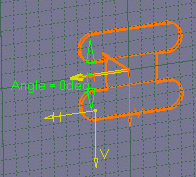
-
Select both top faces of the oblong features of the part (Pad.2 and Pad.3).
The Faces for cut-out field is updated in the dialog box, and now reads: 2 Faces.
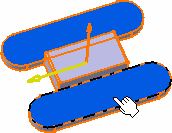
-
Click the Faces for opening field and select the lateral faces of the punch (Pad.1).
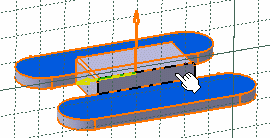
-
Click Apply.
The stamp is previewed with the opening faces:

-
Check the No Fillet button is you do not wish the stamp to be filleted, or set the radius value if you wish the stamp to be filleted.
-
If needed, define the stamp's positioning on the selected wall by choosing:
-
a Reference for rotation: by default, it is the sketch axis, but you can also select any line or edge on the wall.
-
a Rotation angle value: you can either enter a value in the dialog box, or use the manipulator in the geometry to define this value.
-
a new Origin point on the wall to coincide with the punch's point of origin.
This is especially useful for non-circular stamps, but you can very well create the stamp as is, without further positioning.
-
Click OK to validate and create the stamping.
The stamp is automatically set in No Show mode.
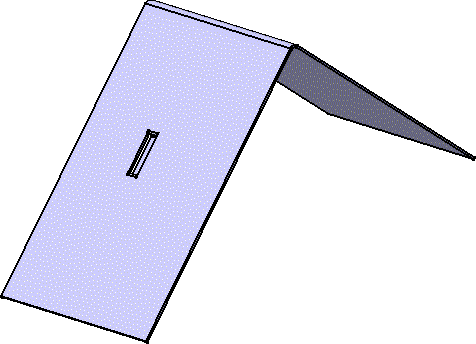
Stamping with opening faces
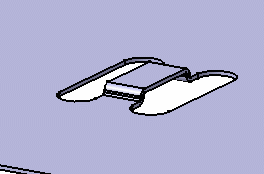
Stamping with opening and cutting faces
- Radius is the radius of the bend between the stamping and the wall.
- Punch is the body you have defined previously. If the punch is in another CATPart document, activate this document before clicking the punch.
- The Faces for cut-out and Faces for opening faces
must be picked on the punch, not on the wall.
If the punch is located into another .CATPart document, these faces must be picked on the copy of the punch where the wall to be stamped is located.
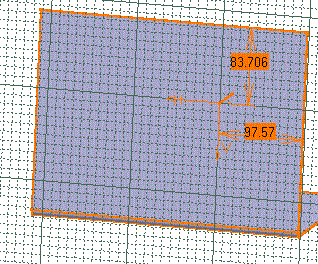
- A user-defined stamping can be edited (punch, die, position, constraints)
- Check the No fillet option to deactivate the Radius R1 value, and to create the stamp without a fillet.
![]()